登录方式
方式一:
PC端网页:www.rccrc.cn
输入账号密码登录,可将此网址收藏并保存密码方便下次登录
方式二:
手机端网页:www.rccrc.cn
输入账号密码登录,可将此网址添加至手机桌面并保存密码方便下次登录
方式三:
【重症肺言】微信公众号
输入账号密码登录
注:账号具有唯一性,即同一个账号不能在两个地方同时登录。
导语:在经口气管插管的危重患者中,来自口咽或胃的细菌可以通过气管导管的气囊迅速定植在下呼吸道,并通过形成生物膜定植在气管导管内部。气管导管的生物膜的形成是导致VAP发生或反复的因素之一。金黄色葡萄球菌是重症监护病房获得性肺炎的常见病原菌。在经口气管插管患者很容易患上由医院病原体如金黄色葡萄球菌引起的呼吸道感染。在治疗MRSA所致ICU获得性呼吸道感染的指南中,IDSA/ATS认为静脉注射万古霉素或利奈唑胺治疗具有同等的功效,而ERS/ESICM/ESCMID/ALAT的指南则更推荐利奈唑胺。关于抗生素对气管导管中生物膜能产生如何影响,目前知之甚少。因此,本研究的目的是比较在利奈唑胺或万古霉素全身治疗下,MRSA呼吸道感染患者的气管导管生物膜和气管导管气囊MRSA的负荷量以及根除效果的区别。
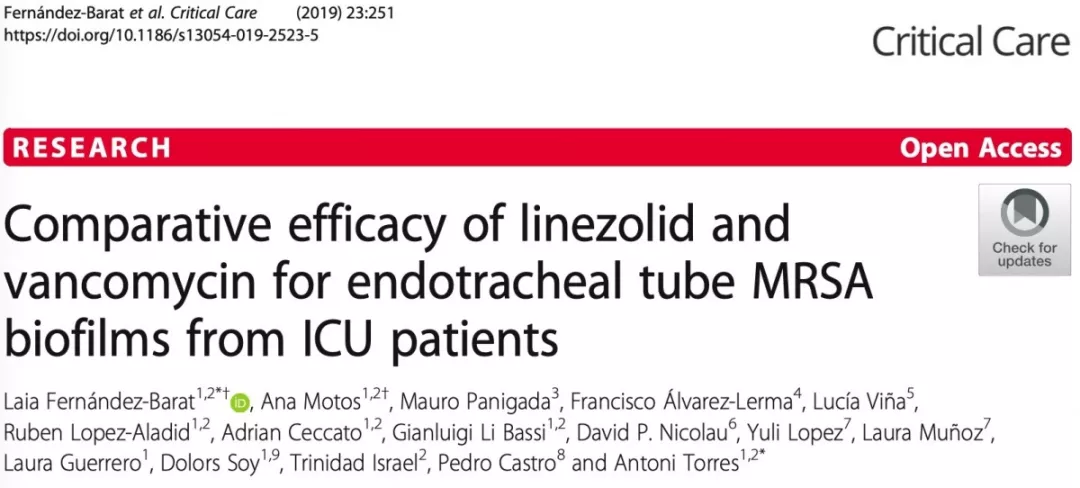
Introduction
In orotracheally intubated critically ill patients, bacteria from the oropharyngeal or gastric microbiota can rapidly colonize the lower respiratory airways passing over the endotracheal tube cuff (ETT cuff) and colonizing the inner ETT surface by forming biofilms.
Thus, these patients are especially vulnerable to developing a respiratory infection caused by a nosocomial pathogen such as Staphylococcus aureus.
ETT biofilm formation is currently considered one of the multiple factors that can lead to VAP or its relapse
MRSA ICU-acquired respiratory infection:LNZ or VAN?
Little is known about how antimicrobials affect biofilm formation during endotracheal intubation.
Purpose: To compare the efficacy of systemic treatment with LNZ versus VAN on MRSA burden and eradication in ETT biofilm and ETT cuff from orotracheally intubated patients with MRSA respiratory infection.
Materials and methods
The study was conducted at the medical and surgical ICUs of four university hospitals in southern Europe, three in Spain and one in Italy.
Inclusion criteria: respiratory infection due to S. aureus (confirmed microbiologically) with ≥ 48 h of orotracheal intubation and ≥ 48 h of treatment with either LNZ or VAN.
Exclusion criteria: Patients with severe immunosuppression were not registered.
Antimicrobial treatment:
The initial empiric antimicrobial treatment →local adaptations of international guidelines
Subsequently revised →microbiology results
Endotracheal tube preparation and microbiology analysis
All ETTs from the patients included were collected and stored at − 80 °C until analysis.
The ETT cuff was dissected and microbiologically processed before rinsing the outer surface and slicing the ETT.
Both ETT cuff and ETT were sonicated before microbiological cultures.
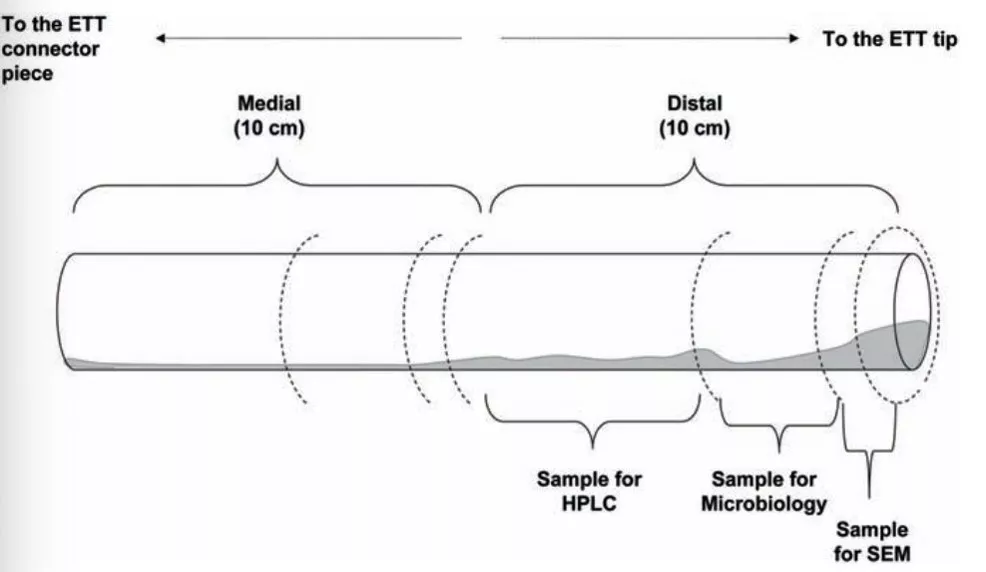
Antibiotic concentration in biological matrixes (i.e., plasma, ETA, and ETT biofilm)
Method:HPLC
The lower limit of detection of HPLC was 2.5 μg ml− 1 for both antibiotics.
When the sample was below detection limit (BDL), the value assigned was 1.25 μg/ml.
Scanning electron microscopy
Biofilm was imaged and thickness measured via scanning electron microscopy (SEM).
We measured minimal, maximal, and mean biofilm thickness using dedicated software.
Results
Twenty-five of them (15 in the LNZ group and 10 in the VAN group) were included in the analysis
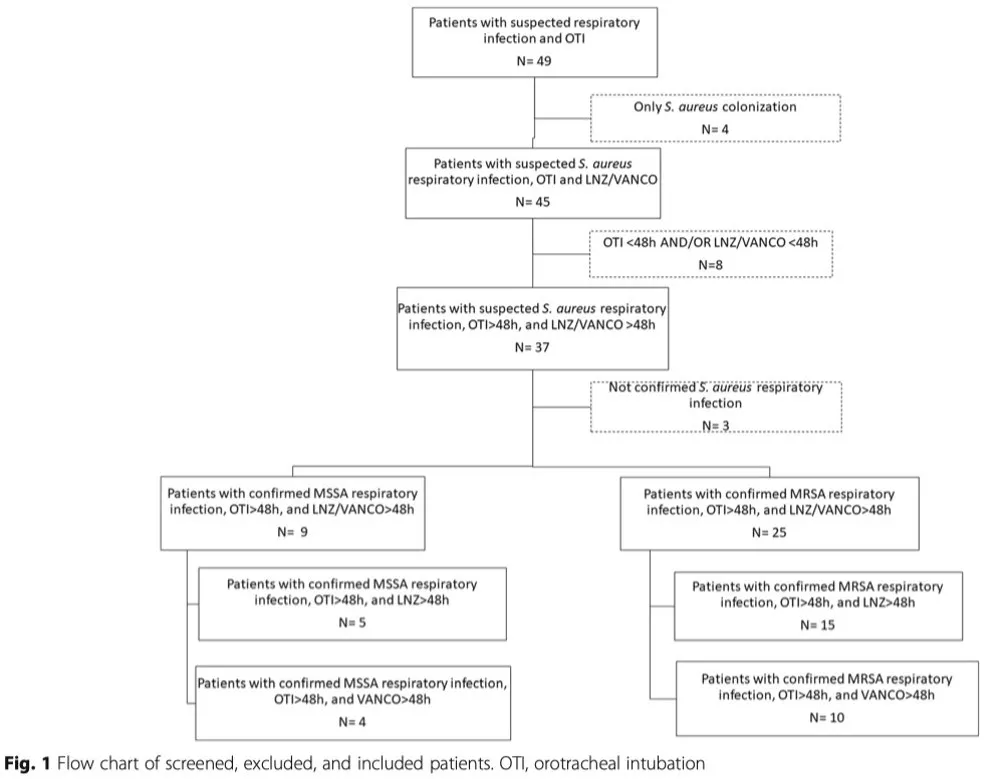
No significant differences were found between groups in terms of baseline clinical characteristics on ICU admission
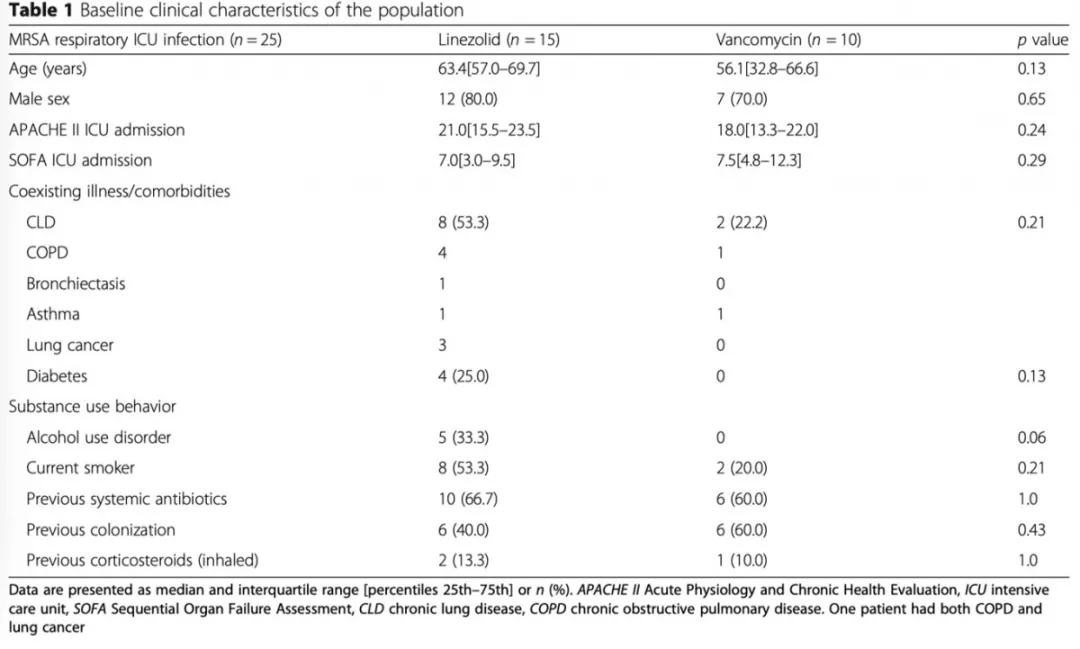
Nor were any differences found at microbial diagnosis or severity according to APACHE II and SOFA scores
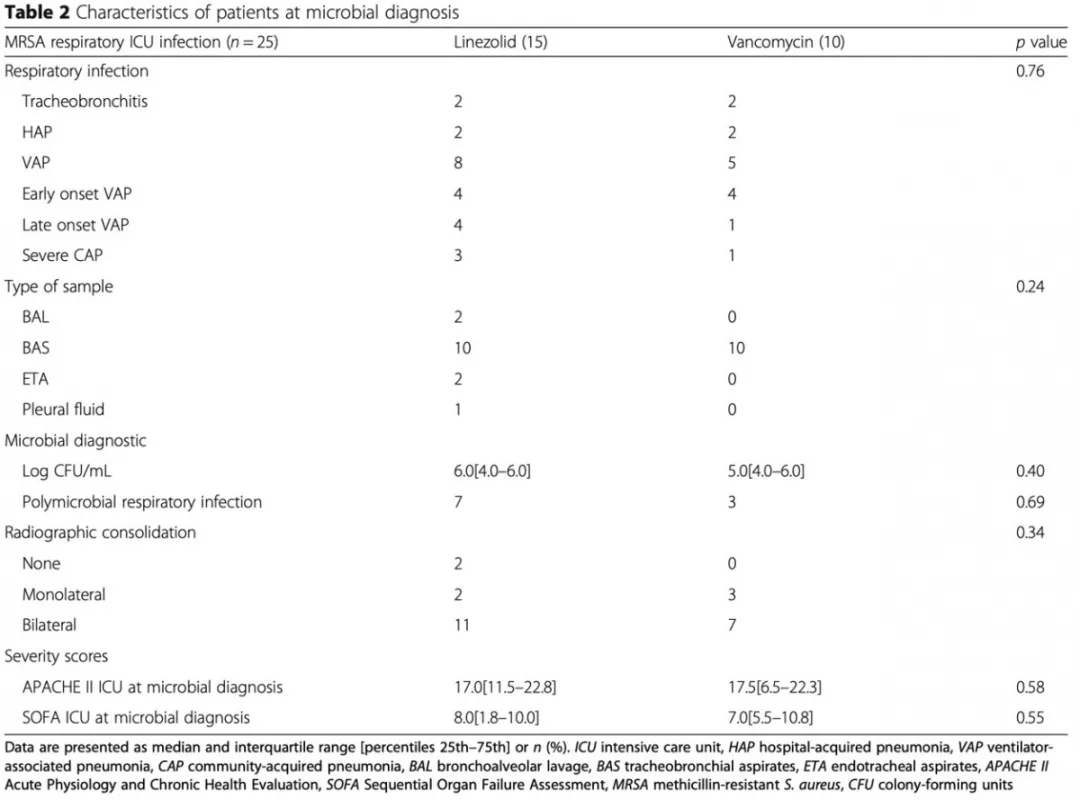
Quantitative microbiology assessment of ETT and ETT cuff
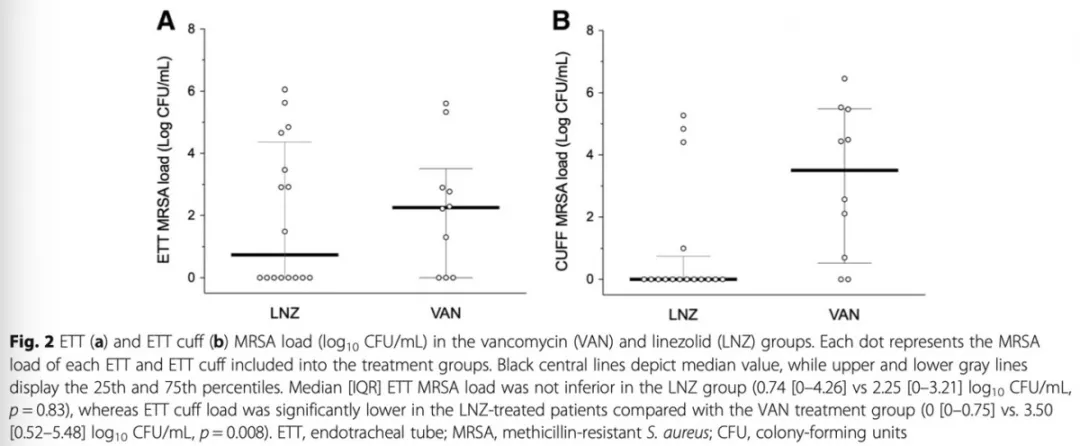
MRSA-positive ETT cuff cultures:LNZ 4/16 (25%) VAN 8/10 (80%),p = 0.031
MRSA-positive ETT cultures:LNZ 8/16 (50%) VAN 7/10 (70%),p = 0.511
MRSA load (log 10 CFU/ml) in the ETT cuff :LNZ 0 [0–0.75] VAN 3.5 [0.52–5.48] , p = 0.008
MRSA load (log 10 CFU/ml) within the ETT :LNZ 0.74 [0–4.26] VAN 2.25 [0–3.21], p = 0.83
Quantitative microbiology assessment of ETT and ETT cuff
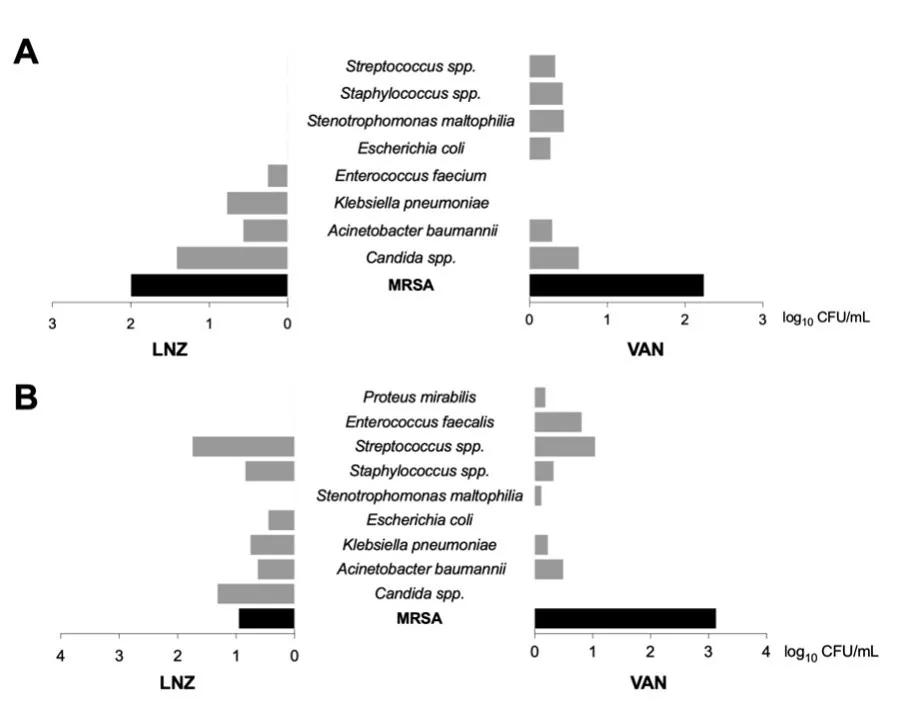
No differences were found between LNZ and VAN groups in terms of the presence and load of Gram-positive agents other than S. aureus or in Gram-negative bacteria including Enterobacteriaceae, either in ETT or in ETT cuff.
LNZ and VAN concentrations in biological matrixes
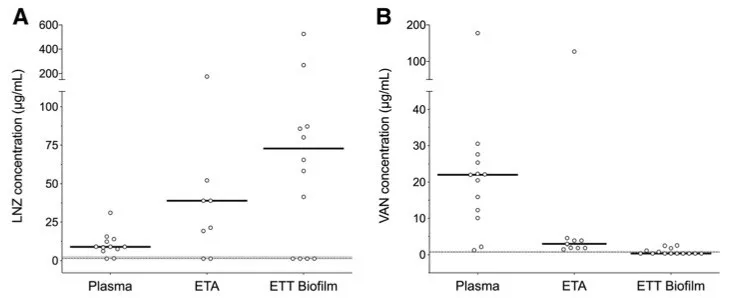
plasma concentrations(μg/ml) : LNZ 9.00 [6.51–13.46] VAN 22.04 [11.18–26.54], p = 0.024
concentration within ETT (μg/ml) : LNZ 72.81 [1.25–127.05] MIC 1.50 [1.00–3.00] ;
VAN 0.35 [0.35–1.31] MIC 0.75 [0.50–1.00] ;p < 0.001.
BDL in ETT biofilm samples :LNZ 28.6%;VAN 64.3%
within ETT biofilm:LNZ 27.64 [1.25–43.69] folds above S. aureus LNZ MIC;
VAN 0.70 [0.47–2.00] folds above S. aureus VAN MIC, p = 0.013.
Clinical outcomes
No significant differences between groups were found in length of mechanical intubation or ventilation between LNZ and VAN
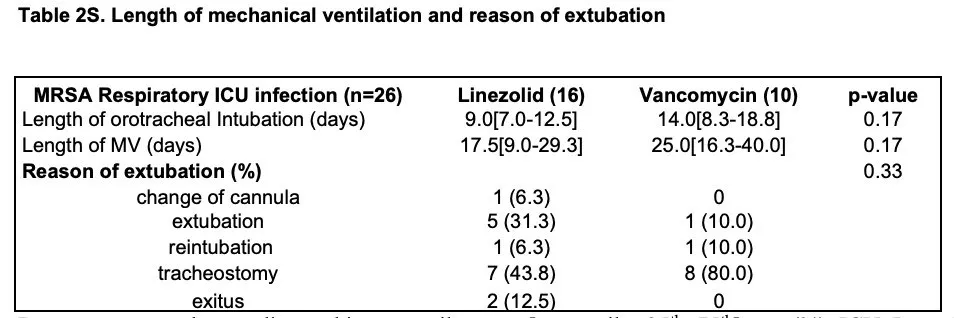
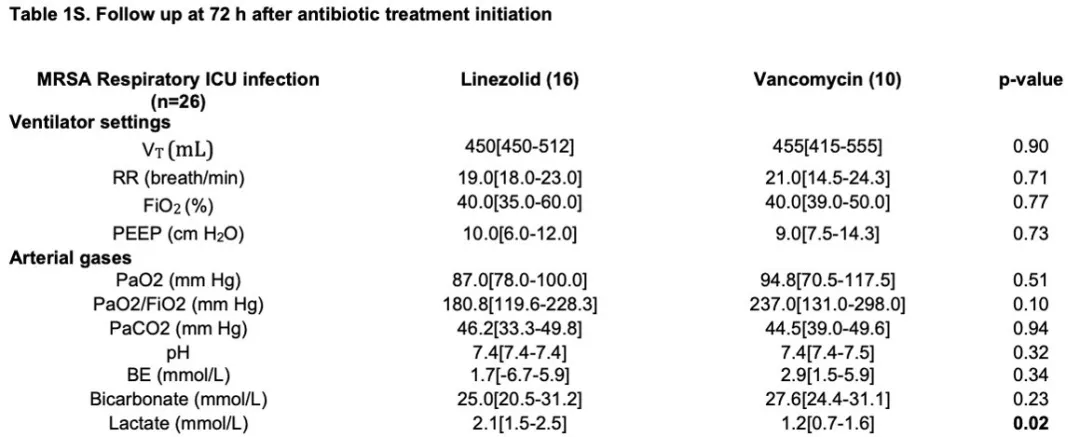
Biofilm through SEM
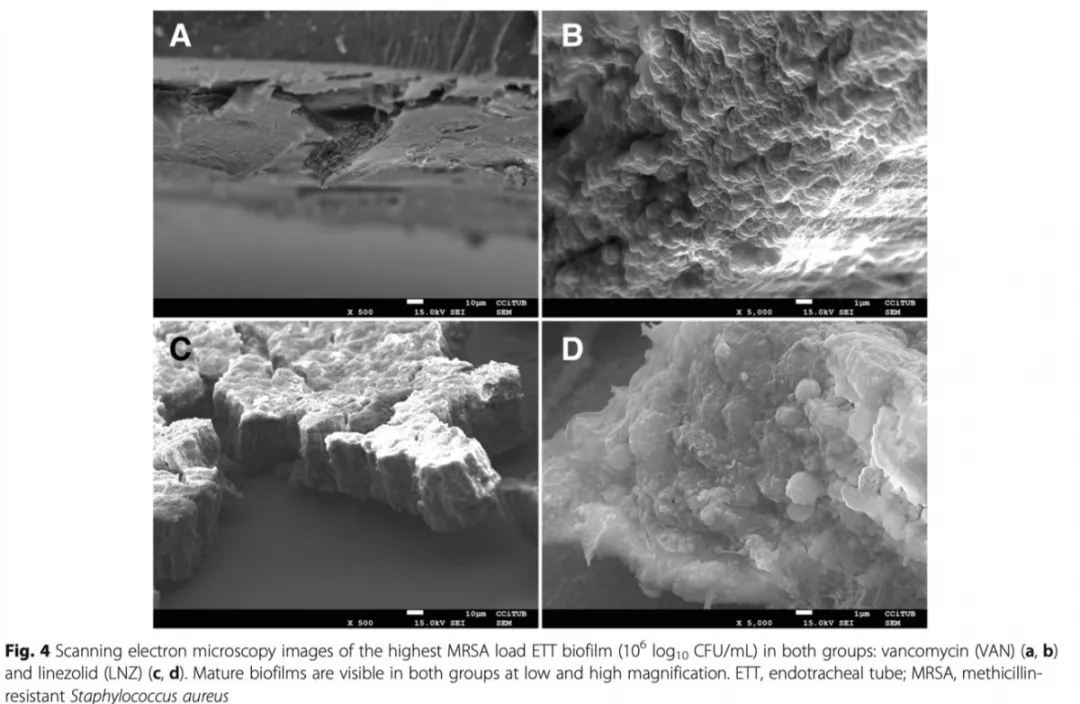
Overall, within the 15 MRSA-positive ETTs, minimal, maximum, and mean thickness did not differ between LNZ and VAN groups.
Conclusions:
In ICU patients with MRSA respiratory infection intubated for long periods, systemic treatment with LNZ obtains a greater beneficial effect than VAN in limiting MRSA burden in ETT cuff.
Advantages:
The first report comparing the effects of LNZ and VAN in ETT from mechanically ventilated humans.
This additional benefit of linezolid should be taken into account when choosing the antibiotics to treat MRSA VAP.
Limitations:
Patients received concomitant antimicrobials that may have combined effects with vancomycin or linezolid.
Lack of correlation analysis.
启发
积极探索各个药物组织浓度、疗效(微生物方面和临床方面)之间的关系。
多角度、从临床中可收集到的标本进行尝试
 后可发表评论
后可发表评论

相关推荐
1
mNGS联合常规微生物检测可缩短ICU内SCAP的临床改善时间!詹庆元教授团队发表全球首个mNGS临床应用前瞻性随机对照研究
4786
2
文献学习46|mNGS在肺部感染应用中的进展及思考(二)
3430
3
文献学习53|宏基因组二代测序在肺部真菌感染诊断中的应用:肺活检与支气管肺泡灌洗液比较
3197
4
文献学习7 | ICU超声肌肉评估
3151
5
文献学习28 | 重症监护室获得性衰弱
3130
6
文献学习45|mNGS在肺部感染应用中的进展及思考(一)
2898
7
文献学习37 | 经皮膈肌电刺激系统在机械通气患者应用的初始评估
2770
8
文献学习12 | 肌松剂在ARDS中的早期应用
2451
9
ARDS免疫精准诊断和治疗之困惑、挑战和策略
2171
10
文献学习1 | ECMO治疗的重症患者中,阿米卡星峰浓度不足的预测因素
2070



友情链接
联系我们
 公众号
公众号
 客服微信
客服微信